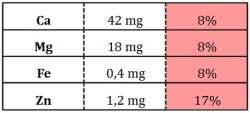Our meals are mineral defficient
Based on actual data
A lack of calcium, magnesium and iron
In Japan, less and less people are eating home-cooked meals. Processed foods account for 55% of households’ food and drink expenditures, eating out for 30%, while fresh foods to be cooked at home only make up about 15% of these expenses.
However, the nutritionists are calculating the nutrient intakes using the “Standard tables of food composition in Japan”, which are based on the quantity of nutrients in home-cooked foods. The national studies on nutrient intakes are also based on these same “Standard tables of food composition”.
According to those tables, Japan’s current situation is the following :
- The intakes of calcium (Ca) are far lower than the Estimated Average Requirements (EAR), which are the necessary nutrient intakes to satisfy the needs of 50% of the people in a specified age group
- The intakes of magnesium (Mg) are a little under the EAR
- The intakes of zinc (Zn) are a little lower than the Recommended Dietary Allowances (RDA), representing the requirements of 97.5% of healthy individuals in each life-stage and sex group
As the proportion of processed foods and meals eaten out is reaching 85%, we decided to carry out studies about the situation and started in 2010 to measure the quantity of the 5 main minerals present in these products. We found out that their quantities were lower than the amounts indicated on the “Standard tables of food composition”. Since then, we have analyzed more than 80 food products, and demonstrated than the Japanese population’s mineral intakes are far lower than the figures calculated by the nutritionists and transmitted to the government.
This is the reason why people relying too much on processed foods or often eating out, not taking minerals from any another source, are affected by mental and physical diseases resulting from a deficiency in calcium, magnesium and iron. However, we have not taken into account the intakes of calcium, magnesium, iron and zinc resulting from the consumption of milk, yoghurt, nuts, pastries and supplements. People taking enough minerals through those products may not be suffering from mineral deficiency.
As for vitamins, we have only analyzed frozen foods and cut vegetables, but they were poor in vitamins B1, B2 and C compared to home-cooked products. Those vitamins are indeed lost or destructed during the food processing.
This is the current situation of Japanese meals.
Analysis of meals
Measurements of the amounts of minerals have been realized by product category. The samples analyzed were made of a mix of the most popular brands’ products, and then sent to be analyzed in a laboratory. This is why our figures are quite representative of the products sold on the market.
Unlike vitamins, the stability of minerals ensures accurate measurements.
In the case of products constituting a whole meal, like bento, we compared their nutritional values with the EAR to calculate the risks resulting from mineral deficiency. In the case of products only representing part of a meal, we analyzed them case by case.
Hereunder are the data of those analyses.
Bento (average of 11 different bentos)

(the percentage is the comparison made with the EAR for a 18-29 years old man)
* There was only one bento which was containing more minerals than the RDA, which is a proof of its healthiness.
Meals at school cafeterias or staff canteens (average of 5 different places)

(the percentage is the comparison made with the EAR for a 18-29 years old woman)
* Meals analyzed: the meals of a canteen situated in a building hosting many companies, 2 kinds of meals provided by the Ministry of Health, Labor and Welfare, one from the Ministry of Education, Culture, Sports, Science and Technology and one from Kagawa Nutrition University. All 5 were deficient in Ca, Mg and Fe. It means that people often eating at a canteen will eventually suffer from diseases resulting from mineral deficiencies.
Pasta (3 kinds from 3 popular casual dining restaurants)

(the percentage is the comparison made with the EAR for a 18-29 years old woman)
* As Japanese people don’t eat pasta very often, they won’t be affected by their lack of minerals. But if those figures were the same for the Italian pastas, Italian people would all be mineral deficient and many of them would eventually die due to mineral deficiency. There is no doubt that even if they look like the same, Italian pastas are quite different from the pastas sold in Japan.
Prawn pilaf (frozen food, 1 bag)

(the percentage is the comparison made with the EAR for a 18-29 years old woman)
* The prawn pilaf is sold in small quantities in the convenience stores. To reach the daily necessary amount of calories, even women should eat 2 bags of it. But even then, the intakes of Ca, Mg and Fe would only reach 40% of the EAR. People often eating this are sure to become sick.
Mc Donald’s
On its homepage, Mc Donald’s is publishing the values of Ca and Fe, but we still measured them. We actually found a difference of 20% with the real figures.
Very few people would eat only 1 hamburger for lunch, but we compared it with the EAR to know how much you should eat to reach the recommended intake. Because Mc Donald’s products are very poor in magnesium and zinc, you should also think of another source of minerals to counterbalance the lack of those 2 minerals and not getting ill.
Hamburger (quantity: 1)
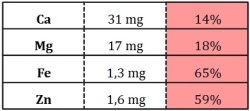
(the percentage is the comparison made with the EAR for a 18-29 years old man)
* It is easy to counterbalance the lack of Ca by drinking milk.
Some people call this hamburger the “Worst food possible”, but eating 2 of them is enough to make up for the daily iron needs. So it shouldn’t be called the “worst”.
Pork Burger (quantity : 1)
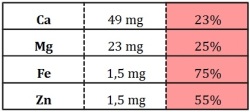
* Eating 2 of them is enough to make up for the daily iron needs.
McChicken (quantity : 1)

* Even eating 2 of them wouldn’t be enough to meet the EAR for Ca, Mg, Fe and Zn. This is a product bad for the health.
Chicken McNuggets (1 box)

* Even eating 2 of them wouldn’t be enough to meet the EAR for Ca, Mg, Fe and Zn. Eating McChicken and Chicken McNuggets on a regular basis would get you sick. The combination of those 2 can really be called “The worst food possible”.
Sandwich (on average)
Powder Soup (average of 1 bag)

*Eating 2 sandwiches and soup would be enough to satisfy one’s appetite, but would cause a large deficiency in all 4 main minerals.
Soup from a soup restaurant (for 1 person)

*The soups from the soup restaurant were containing fewer nutrients than homemade soup but still more than powder soups. Eating something rich in magnesium besides this soup would allow to meet the EAR.
Instant Noodles (cup noodles)
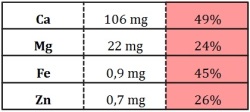
*As instant noodles are sold in small quantities, they contain few minerals. Moreover, they are poor in magnesium and zinc, so it is necessary to add ingredients so as not to get sick.
Gyoza (frozen, for 1 person)
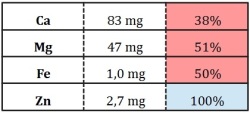
*As many other food products, they are poor in calcium, magnesium and iron. That is why even when combined with other products, there is a high risk of minerals deficiency.
As we analyzed more than 90 food products, we found some products exceeding the RDA :
➢ For calcium: pizza
➢ For magnesium: good quality soba (Japanese buckwheat noodles) or mabo tofu (Sichuan style bean curd)
➢ For iron: liver cooked with Chinese chive
➢ For zinc: deep-fried oysters
However, few Japanese are eating those dishes on a regular basis, leading to many cases of diseases caused by mineral deficiencies.
Fewer minerals than in homemade dishes
We then calculated to what extent the products on the market were poorer in minerals than homemade dishes.
The potato salad and macaroni salad were containing less than half of the minerals of homemade dishes.
The salad of great burdock root, only eaten in Japan, was even worse. The products on the market were only containing 20% of the minerals contained in a homemade salad.
Potato salad (100g)

The percentage represents the difference between the amount of minerals in the products on the market and homemade dishes.
Macaroni salad (100g)

The percentage represents the difference between the amount of minerals in the products on the market and homemade dishes.
Healed by meals rich in minerals
Many people are deficient in calcium, magnesium, iron and zinc because of today’s meals.
People have become sick because of the lack of those minerals indispensable to the body, so we naturally thought that compensating for those minerals would heal them. As we actually carried out the experiment, we assisted to people healing partially, and in many cases completely, from diseases that wouldn’t have improved before.
Examples of children whose conditions have improved (34 children)
( ): number of children
Asperger’s syndrome (4)
Suspicion of Asperger’s syndrome (2)
High-functioning autism (1)
Pervasive developmental disorder (4)
ADHD (Attention Deficit Hyperactivity Disorder) (3)
Autism (3)
Autism spectrum disorder (1)
Speech impediments / gait abnormalities (1)
Hypothermia (7)
Atopic dermatitis (1)
Tactile hyperesthesia (1)
Sleep disorders (3)
Social withdrawals (2)
Down’s syndrome (1)
Examples of adults whose conditions have improved (42 people)
( ): number of people
Schizophrenia (1)
Depression (7)
Bipolar disorder (3)
Sleep disorder (1)
Menopausal disorder (1)
Graves’ disease (1)
Dementia (1)
Overeating (1)
Rheumatism (1)
Multiple chemical sensitivity (2)
Diabetes (1)
Empyema (1)
Sleep apnea syndrome (1)
Constipation (3)
Bad eyesight (2)
Hypothermia (5)
Dry skin (4)
Lumbagos (2)
Mouth ulcers (2)
Atopic dermatitis (1)
Hypotension (1)
As people are irritable when they are hungry and calm down after eating, they are also irritable when they are mineral deficient, and calm down after eating foods rich in minerals. This is the same for other conditions, if people keep on eating food products rich in minerals they will get better, and even heal completely for some of them.
Even though it is proved that many people are suffering from diseases resulting from mineral deficiencies, doctor are treating everyone with medication only. That is why medical costs are so high while people don’t get better.
How to get enough minerals ?
We are counterbalancing these mineral deficiencies with a Japanese traditional condiment: dashi (Japanese soup stock made from fish and kelp).
To make this dashi, we use Japanese pilchard, flying fish and kombu (originated from areas not contaminated by radioactive pollution) and make a liquid soup stock from them, which contains all their minerals. We also make a powder version of this soup stock and another one where we add sesame.
The loss of minerals in the meals is most probably not only occurring in Japan, but in the whole world. Almost no minerals are contained in today’s condiments, which is one of the causes of the current situation.
In many cases, mineral deficiencies also dull the sense of taste, leading to an unbalanced diet provoking mental and physical disorders. Against this phenomenon, the use of multi-minerals supplements containing zinc is efficient.
However, we must eventually get back to meals and food products rich in minerals so as to eradicate this cause of disease.
Representative : Junichi KOWAKA

